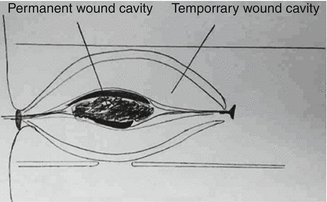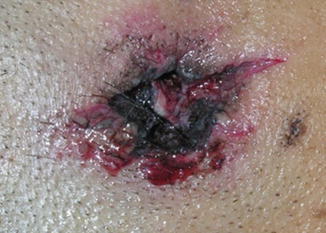Fig. 7.1
Kinetic energy of the bullet dissipates in the wound track and another way, which causes damage outside the track

Fig. 7.2
The energy and heat expand explosively, causing a cavity in the tissue

Fig. 7.3
Round entrance gunshot wound showing dark soot deposition with marginal abrasion

Fig. 7.4
Stellate-shaped entrance wound with soot
2.
Abrasion ring (marginal abrasion, contusion ring)
Bullet indents the skin and abrades the margin of entrance wound.
3.
Crush and laceration
Direct laceration and disruption of the tissues occur along the track with any penetrating object and effects of gases.
4.
Secondary shock wave
Tissue damage may occur in the remote tissue caused by the kinetic energy of a high-velocity bullet which produces a shock wave.
5.
Skin burn
The bullet’s kinetic energy is converted to heat. Heat is transmitted to the surrounding tissues.
6.
Bullet wipe
Lubricant and debris on bullet surface wiped off onto the wound edge.
7.
Smudging
Soot from partially burnt gases.
8.
Tattooing
Burning propulsive grains embedded in the skin.
9.
Retained foreign materials
GSWs penetrate the soiled clothing and introduce foreign bodies such as lubricant, debris, and bacteria into the wound track. They are the source of wound contamination. Retained wadding and bone fragment should be removed.
7.4 General Principles of GSW Management
1.
Save life
For initial management, ATLS protocol should be performed.
2.
Local wound care to prevent infection
Control bleeding: Wound hematomas (Fig. 7.5) lead to infection [4].

Fig. 7.5
Gunshot wound with hematoma
Cleansing
Adequate debridement [4]: Debridement of all grossly nonviable tissues should be undertaken.
Stay updated, free articles. Join our Telegram channel

Full access? Get Clinical Tree








